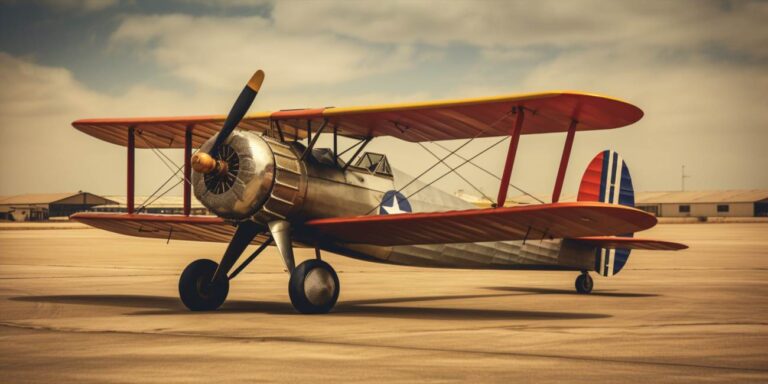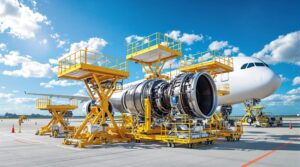The early 20th century witnessed a proliferation of experimental aircraft, each contributing to the unfolding narrative of the history of airplanes. From biplanes to monoplanes, designers explored diverse configurations, seeking the optimal balance between stability and performance. The iconic Sopwith Camel, a World War I fighter, exemplified the rapid advancements in aeronautical engineering during this epoch.
Amidst the turbulence of war, aviation technology matured swiftly. The interwar period saw the emergence of commercial aviation, with pioneers like Charles Lindbergh capturing the public’s imagination through daring transatlantic flights. The introduction of metal airframes, exemplified by the Boeing 247, marked a pivotal juncture in aircraft construction, heralding an era where airplanes became symbols of global connectivity.
The crucible of World War II propelled aviation into the jet age. The Messerschmitt Me 262, the world’s first operational jet-powered fighter aircraft, showcased the transformative power of jet propulsion. Post-war, the jet age flourished, epitomized by the Boeing 707, a trailblazing commercial jetliner that revolutionized air travel, making it more accessible to the masses.
The latter half of the 20th century bore witness to unprecedented strides in technology. Supersonic flight became a reality with the iconic Concorde, an engineering marvel that could traverse the Atlantic in under three hours. Simultaneously, innovations like fly-by-wire systems and composite materials redefined aircraft design, enhancing safety and efficiency.
In the 21st century, airplanes continue to evolve, guided by the principles of sustainability and efficiency. Electric and hybrid propulsion systems promise a greener future for aviation, while advancements in materials science contribute to the development of lighter and more fuel-efficient aircraft. The Boeing 787 Dreamliner, with its extensive use of composites, exemplifies this commitment to eco-friendly aviation.
The history of airplanes is a tapestry woven with the threads of human ingenuity, daring exploration, and technological innovation. From the modest beginnings of the Wright brothers to the sleek and sustainable aircraft of the present day, each chapter in this narrative reflects the relentless pursuit of the skies.
Early attempts at human flight and the wright brothers biplane
Early attempts at human flight trace back to the adventurous dreams of visionaries and the audacious endeavors of inventors throughout history. The quest for soaring through the skies ignited the human imagination, but it wasn’t until the late 19th and early 20th centuries that tangible progress was made.
One of the pivotal moments in the timeline of aviation was the emergence of the Wright brothers, Orville and Wilbur. Born in the late 1800s, these aviation pioneers pursued their fascination with flight, eventually culminating in the creation of the Wright biplane.
The Wright brothers’ biplane represented a groundbreaking leap in aviation technology. It featured a biplane design, characterized by two wings stacked one above the other. This design was a departure from earlier monoplane configurations and proved crucial in achieving stability and control during flight.
The key innovations that set the Wright brothers apart included their understanding of aerodynamics and their development of a three-axis control system. Unlike previous attempts at flight, the Wright brothers recognized the importance of controlling the aircraft’s pitch, roll, and yaw for stable and controlled maneuvering.
One of the most notable aspects of the Wright brothers’ aircraft was the utilization of a biplane structure with a wingspan of approximately 40 feet. The wings were equipped with a system of canards, a type of control surface placed at the front of the aircraft, allowing for increased stability and maneuverability.
Powering their aircraft was a 12-horsepower engine, a marvel of engineering at the time. The engine provided the necessary thrust for the biplane to achieve sustained, controlled flight. The significance of this achievement cannot be overstated, as it laid the foundation for modern aviation.
The historic flight of the Wright brothers took place on December 17, 1903, at Kitty Hawk, North Carolina. Orville piloted the aircraft while Wilbur observed. The biplane, known as the Wright Flyer, covered a distance of approximately 120 feet in 12 seconds, forever etching the names of the Wright brothers into the annals of aviation history.
In retrospect, the Wright brothers’ biplane marked a monumental leap forward, showcasing the viability of powered, controlled flight. Their achievements set the stage for rapid advancements in aviation technology, ultimately leading to the sophisticated aircraft that grace our skies today.
The era of propeller airplanes and the first passenger flights
The dawn of commercial aviation marked a transformative era, where propeller airplanes soared through the skies, carrying the dreams of both aviation pioneers and eager passengers alike. In the early 20th century, the world witnessed the advent of propeller-driven aircraft, propelling humanity into a new realm of possibilities.
Before the dominance of jet engines, the heartbeat of early aviation was the rhythmic spin of propellers slicing through the air. These wooden or metal blades, characterized by their distinctive whirring sound, defined the aviation landscape. Zeppelins, colossal airships filled with helium or hydrogen, also played a significant role in this epoch, offering a unique alternative to traditional fixed-wing aircraft.
Imagine a time when the sky was not just a vast expanse, but a bustling highway connecting distant destinations. Passengers, fueled by curiosity and a spirit of adventure, boarded propeller planes and zeppelins, embarking on journeys that transcended the limitations of terrestrial travel. The experience of being airborne, gazing at the world below, was a privilege reserved for those daring enough to step into the world of commercial aviation.
The propeller, with its rotating blades, became the symbol of propulsion, driving aircraft forward and upward. It was the unsung hero of early aviation, propelling not just planes but also the imagination of those who marveled at the skies. Zeppelins, on the other hand, floated gracefully, defying gravity with a majestic elegance that captured the collective fascination of onlookers.
Passengers aboard these airborne marvels were pioneers themselves, venturing into uncharted territory. The cabin of a propeller plane or a zeppelin was not merely a transport vessel; it was a cocoon of exploration, fostering connections and weaving the fabric of global unity. The camaraderie among passengers, sharing the awe of soaring above clouds, created bonds that transcended the confines of the aircraft itself.
Commercial aviation, in its infancy, laid the foundation for a revolution in connectivity. It was a time when air travel was not a routine affair but a grand odyssey. The allure of reaching distant lands, once deemed unreachable, gripped the collective imagination. Propellers and zeppelins were the vessels that carried not just people but the collective dreams of a world interconnected through the skies.
As we delve into the annals of aviation history, the era of propeller airplanes, zeppelins, and the first passenger flights emerges as a testament to human ingenuity and the relentless pursuit of the skies. It was a time when the world looked up, and the propeller became a symbol of progress, carving a path for the future of aviation.
The jet age – how modern planes shaped commercial flying
The jet age ushered in a revolutionary transformation in commercial flying, redefining the skies and propelling the world closer. At the core of this monumental shift were the relentless innovations by aviation giants like Boeing and Airbus, revolutionizing air travel as we know it.
Central to this era was the advent of the jet engine, a technological marvel that propelled aircraft with unprecedented speed and efficiency. This breakthrough powered aircraft like the Boeing 707 and the Airbus A300, marking a departure from traditional propeller-driven planes.
Boeing played a pivotal role in shaping the jet age, introducing iconic models such as the Boeing 747, known as the “Queen of the Skies.” This colossal aircraft redefined long-haul travel, transforming it into a more accessible and efficient experience for passengers worldwide.
| Boeing | Airbus |
|---|---|
| Introduced 707, 747, 777, 787 | Introduced A300, A320, A380, A350 |
| Renowned for pioneering long-haul jets | Focused on fuel efficiency and technological advancements |
Airbus, a formidable competitor, made significant strides in innovation by prioritizing fuel efficiency and advanced technology. Their A320 family and the game-changing A380, the largest passenger aircraft to date, represented a leap forward in comfort and capacity.
Together, Boeing and Airbus have steered the course of the aviation industry, each contributing distinct strengths and innovations. The jet age owes its magnificence to the relentless pursuit of engineering marvels, transforming air travel from a luxury to a global necessity.






